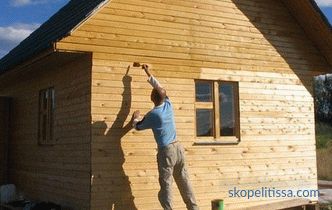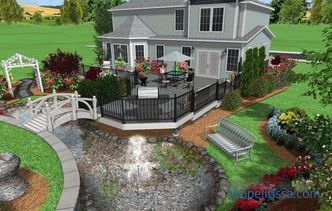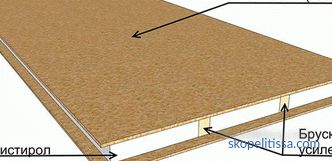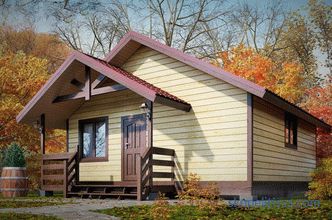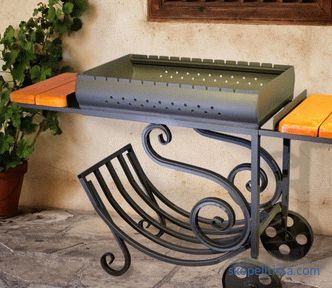Aerated concrete (gas silicate) is one of the most sought-after materials in modern housing construction. Houses made of aerated concrete have become a familiar part of the suburban landscape; from 15 to 20% of new buildings erected over the past 10 years are houses from aerated concrete blocks. The porous structure of the material, characteristic of all lightweight concrete, provides high performance characteristics of the structure. In many cases, the owners decide to conduct additional insulation of the house from the aerated concrete outside. This measure allows you to minimize heat loss and improve housing microclimate.
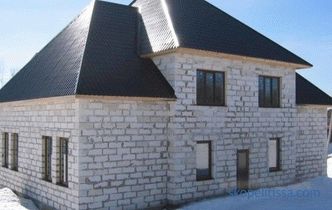
About the need for insulation
The structure of aerated concrete is a complex set system open cells (voids) filled with air. This feature of the structure determines two useful material properties:
-
Good thermal insulation . The manufacturer claims that the porous structure of aerated concrete brings its thermal insulation properties to wood, and is three to four times as good as brick. In the middle lane, according to SNiPs, the thickness of the external walls of 400-500 mm will be sufficient without additional insulation, if a block of the grade not lower than D500 is used. These calculations are correct, but do not take into account the second property of aerated concrete.
-
Gas permeability . Open pores mean that the material is able not only to pass, but also to accumulate moisture, which occurs during the operation of the house. Walls that have absorbed a certain amount of moisture become more dense (in the pores, as in the capillaries, water accumulates). The thermal conductivity of such walls increases, and the ability to retain heat drops, which is especially noticeable in regions with severe winters. And if in the south (where the winter temperature difference inside and outside the building is small) country houses do not need insulation, then to the north they protect the walls without fail.
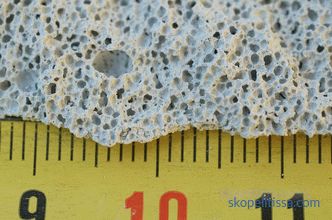
Principles of choosing insulation
When choosing the appropriate material for insulation of aerated concrete walls take into account three factors:
-
The physical properties of the material . Aerated concrete is able to regulate the humidity in the room: the walls breathe, letting the water vapor out. Exterior cladding should not prevent this diffusion.
-
Heater Properties . It should not just be vapor permeable; vapor permeability should be higher than that of aerated concrete blocks.
-
Warming Rule . It states: the vapor permeability of each subsequent layer of facade insulation should increase. If the selected material cannot pass air outside without difficulty, then a ventilated gap is surely arranged behind it.
Compliance with these conditions helps move the dew point beyond the walls. If the masonry is not protected by anything, the moisture that accumulates inside, in severe frost, inevitably freezes. This leads to tangible heat loss; after several cycles of freezing and thawing, the destruction of the surface layer of the blocks may begin.
It is good to know! The dew point is a plane in the thickness of the wall, where, due to the difference between external and internal temperatures, condensation of water vapor into dew occurs. With proper organization of outdoor insulation dew point shifts outward and can not harm the walls.
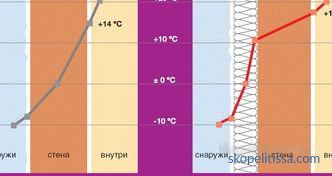
Not only the correct insulation, but also the quality of the masonry wall affects the energy efficiency of the house. If the interblock seams are made with violations (too thick), even a high-quality insulation will not give the desired effect. The optimum glue seams are 1.5-2 mm thick. Laying blocks on cement-sand mortar with a seam of 10-12 mm will increase heat loss (and heating bills) by 20-20%.
Types and advantages of facade insulation
There is an alternative possibility - insulation of the building from the inside. This option is less preferable for several reasons:
-
Living area will decrease.
-
A installation of an effective ventilation system is required.
-
A high risk of mold formation will appear as the dew point shifts inside the dwelling. Moisture and heat are optimal conditions for unpretentious microorganisms and fungus.
Outdoor insulation not only increases the service life of the walls, but also preserves the usable floor space. Mineral wool, polystyrene, and polyurethane foam and penoplex (extruded polystyrene foam) are considered to be suitable materials.
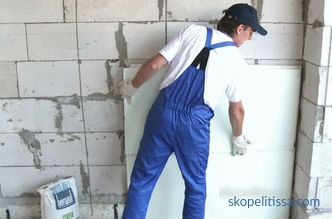
Considering various options for how to insulate a house made of aerated concrete from the outside, many opt for plain or mineral plaster; the latter is specifically designed for aerated concrete walls.The layer of insulation can be sheathed with several finishing materials:
-
Siding or clapboard .
-
Facing brick or decorative stone .
-
Plastering .
-
Grouting joints with subsequent use of vapor-permeable facade paint .
The installation of the insulation layer on the outside has the following positive aspects:
-
The energy efficiency of buildings increases and heating bills are reduced.
-
Bearing walls are not exposed to natural forces, which increases the operational life of country houses.
-
Together with the improvement of sound insulation of walls the comfort of living increases.
-
Improves the appearance of facade walls .
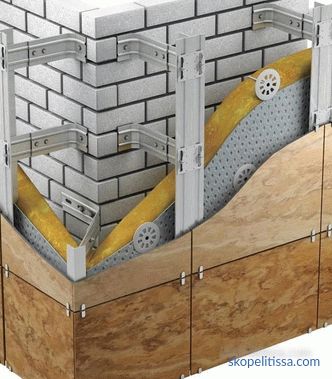
On our website you can find contacts of construction companies that offer a home insulation service. Directly to communicate with representatives, you can visit the exhibition of houses "Low-rise Country".
Thermal insulation foam
Polyfoam is a common method of thermal protection of the facade. It is valued for its low weight, due to which the material does not exert pressure on the walls and foundation, and ease of installation. Another important advantage is the cost, which is two times lower than the cost of mineral wool. In addition to the advantages, the foam has one unsuitable quality for aerated concrete.
It is known that the vapor permeability of the wall layers should increase from the inside to the outside. Conventional extruded foam does not allow steam (it has zero vapor permeability). If it is used for plastering aerated concrete, moisture will accumulate in the wall, impairing its characteristics. The output will be a single-level wooden frame, with a ventilation gap. Warming of the house of aerated concrete foam is carried out in the following order:
-
Preparing the facade . If it was built from non-autoclaved gas blocks, leveling of the surface may be required. If the blocks are autoclaved, the surface is cleaned and primed.
-
Mounting the profile . On the facade are fixed guides frame system.
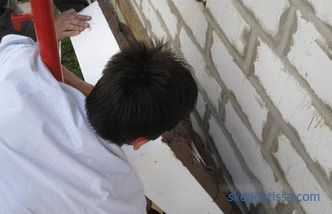
-
Installation of foam . It is placed in the gaps between the frame elements, additionally fixing with foam or glue.
-
Fixing plates . The foam plating is additionally reinforced with plastic dowels (metal ones are not suitable, since they create cold bridges).
-
Decorative Trim . A primer is applied to the foam layer, fiberglass mesh is fixed on top, then reinforcing glue is applied. After the glue dries, decorative or warm plaster is applied.
It can be interesting! In the article on the following link read about outdoor insulation of the house with mineral wool under siding.
Thermal insulation with mineral wool
Minvat is represented on the market in the form of plates and rolls. It is actively used for insulating facade walls; Basalt slabs - a special case of mineral wool, with similar qualities and performance characteristics. The wide distribution of mineral wool is due to its many positive qualities:
-
Good vapor-permeable properties .
-
High strength and immunity to biohazards. Available material with different categories of rigidity.
-
Fire resistance (when ignited, it does not burn but melts).
-
Environmental friendliness . The basis of mineral wool - natural ingredients that are not dangerous to human health.
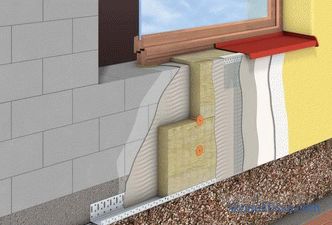
The installation of mineral wool along the facade is carried out in the following order.
-
Facade Preparation . The wall is cleaned and leveled with cement mortar. Then the surface is primed, and if necessary, additionally leveled with vapor-permeable plaster.
-
Mounting frame . The guides of the frame structure are fixed according to the size of the material used (roll or rectangular mats). Due to the frame, there is a ventilation gap, which is sufficient for air circulation along the wall and steam removal.
-
Securing of mineral wool . It is carried out with the help of glue applied to the plate material. Additional fixing provide plastic dowels, umbrellas.
-
Preparation for finishing . The layer of mineral wool is reinforced with mesh and glue.
-
Finishing . Walls are covered with a primer and plastered; The second most common option is to coat and paint.When finishing do not use acrylic plaster, which has moisture-proof properties; this coating will cause condensation to form.
On whether it is necessary to warm the aerated concrete walls in the following video:
This can be interesting! In the article on the following link read about the insulation of the basement of the foundation outside.
Polystyrene foam
Extruded polystyrene foam (EPS) is a type of foam plastic. Polystyrene is produced by foaming the original ingredients at high temperature and pressure. The method of obtaining causes the physical properties of the material - it turns out to be mechanically strong, frost-resistant and may have a different density. The higher the density (and strength) of EPPS, the higher the thermal conductivity. Steam and air permeability are always at the same (low) level, and water absorption is minimal. The combination of qualities allows to widely apply EPS as a warming facade material.
An undesirable property of polystyrene foam for aerated concrete walls - low vapor permeability, which leads to the appearance of a thermos effect and a dew point displacement, is circumvented by means of a ventilation gap. As in the case of foam, the second option is possible - the installation of a powerful supply and exhaust ventilation. Installation of the heat-insulating layer and decorative finishing is carried out according to the same scheme as for the foam plastic.
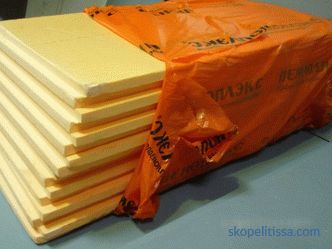
Polyurethane foam (PUF)
Material refers to sprayable substances; its application requires special equipment, which makes it not the most popular choice in private housing construction. After spraying, a uniform hermetic layer with the following properties is formed on the wall:
-
PPU penetrates into the porous surface layer of the concrete facade and forms with it a strong bond not collapsing with time.
-
Thermal conductivity PUF, depending on density, occupies an intermediate value between the foam (minimum coefficient of thermal conductivity) and mineral wool.
-
The required thickness of polyurethane foam is determined by the brand of material and is from 5 to 10 cm (in the middle lane). The service life of such a coating is at least 25 years.
-
Vapor permeability of PPU after solidification is comparable to that of reinforced concrete, the filtration of air and water vapor stops completely. For removal of water vapor accumulating in the premises, an effective ventilation system is organized.
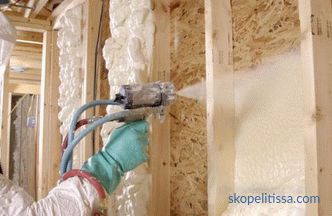
-
If the outer insulation layer is selected PUF (and also polyfoam or EPS), for the premises a decoration is chosen that does not allow steam to penetrate into aerated concrete . Cement plaster and alkyd paints are suitable for this role, often using ceramic tiles and vinyl wallpaper.
Methods of attaching insulation to the facade
In practice, three technologies are used to insulate external gas-block walls.
-
Hinged facade . It is a wooden or metal frame construction, the pitch of which is equal to the width of the insulating material. Insulation fits into the cells of the frame, mounted on top of the decorative layer.
-
Wet facade . Aerated surface cleaned. The selected insulation material is attached to the adhesive composition and additionally fixed with dowels. Then the wall is plastered in 2 layers along the reinforcing mesh.
-
Wet facade with reinforcement . If a brick or natural stone is selected as the finishing cladding material, hooks are used to fix the insulation. Then the surface is reinforced with mesh and plastered. After the plaster dries, lining is carried out; the method allows to do without strengthening the walls and the foundation and in many cases is preferred.
About the insulation of the house from aerated concrete with mineral wool in the following video:
It can be interesting! In the article on the following link read about the insulation of a wooden house outside.
Cost of works on weatherization of the facade of a gas-concrete house
Construction organizations offer insulation services and plastering of the facade of a house of gas concrete, the price of which is determined by several factors. The exact estimated cost of work is determined by direct inspection of the house. The cost of work is influenced by the following parameters:
-
House inspection (the service is free of charge in most cases if an agreement has been concluded).
-
Geometric features of walls, number of floors, and surface area.
-
Specialist consultation for choosing the optimal thermal insulation.
-
Drawing up estimates .
-
Purchase and delivery of materials .
-
Work on insulation and finishing of the facade.
-
Removal of construction garbage .
On errors in the insulation of aerated concrete in the following video:
The cost of some work on the preparation and insulation of the facade in Moscow and region (for m 2 , without the cost of materials) has the form:
-
Construction scrapping and dismantling: 50-55 rub.
-
Facade surface cleaning: 90-110 rub.
-
Insulation of the exterior walls of the mineral wool: from 375 rubles.
-
Installation of mineral wool on glue with dowel: from 425 rub.
-
Wall insulation with polystyrene foam: from 430 rubles.
-
Foam mounting to glue: from 400 rub.
-
Heat insulation PPU: thickness up to 3 cm - 600 rub. , thickness 5 cm - 750 rub.
-
Reinforcing of walls with fiberglass mesh: from 400 rub.
-
The device of the reinforcing layer over the insulation: 380-420 rub.
-
Decorative plastering: from 380-430 rub.
-
Finishing: from 400 rub.
-
Facade decoration with artificial stone: from 1250 rub.
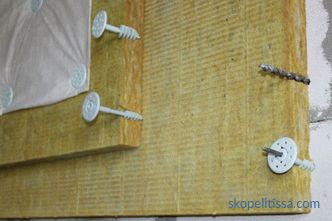
On our site you can familiarize yourself with the most popular projects of houses from aerated concrete blocks from construction companies represented at the exhibition of houses Low-rise Country.
Conclusion
The vapor permeability of aerated concrete walls is a valuable quality for a country house. Incorrect installation of the facade insulation layer will not only not give the expected effect, but also entail undesirable consequences from the thermos effect, until the appearance of mold. Appealing to experts will help avoid annoying mistakes, make the house warm and comfortable.
